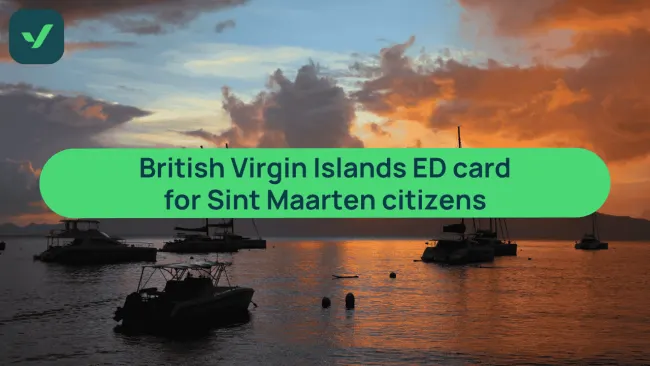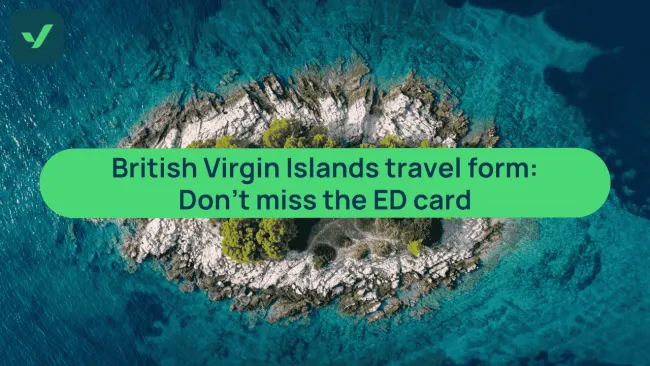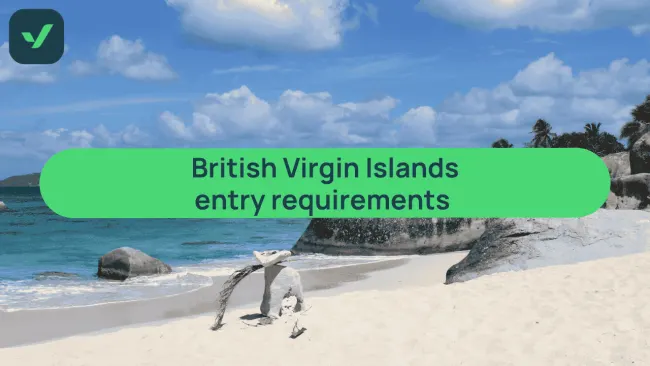
Welcome to UK Virgin Islands

The exclusive British Virgin Islands, also known as Nature's Little Secrets, are easily the best sailing destination in the Caribbean. And even for non-sailors, there are some amazing activities, such as snorkeling, national parks, and amazing white sandy beaches. Let’s explore!
Read our ultimate British Virgin Islands travel guide to plan your trip, including what to see and do and how to get there.
Document checklist for the British Virgin Islands
-
Visa (if applicable)
-
Valid passport
-
Sufficient funds to cover your trip
-
Return or onward ticket
Essential British Virgin Islands travel information
-
Currency - The official currency of the British Virgin Islands is the United States dollar ($), also used by the United States Virgin Islands.
-
Daily budget for 1 person - Allow a daily budget of $100 per person, per day.
-
Languages - British Virgin Islanders speak English, the English-based Virgin Islands Creole, and Spanish
-
Number of travelers per year - In 2016, the British Virgin Islands exceeded the 1 million visitor mark for the first time.
-
Socket type - Type A and B, and 110 volts at 60 Hz.
-
Time zone - Atlantic Standard Time (GMT-4).
-
Top 3 cities/islands to visit - Spanish Town on Virgin Gorda Island, Norman Island, and Tortola.
-
Top 3 landmarks/monuments - The Baths, Rhone Marine Park (Salt Island), and Fallen Jerusalem National Park.
Visa information for the British Virgin Islands
Many visitors to the island chain do not require a visa for stays of up to 30 days, including nationals of the United States, the United Kingdom, and Europe.
Use our Visa Checker Tool to determine which travel documents are needed for your trip.
Visa difficulty index for the British Virgin Islands
Accessibility: 4/5
The British Virgin Islands does not require a visa for many visitors. However, those that do need a visa, must apply via an embassy or consulate.
Time to get your visa: 3/5
The visitor visa is usually processed between 7 and 10 days after the application date.
Costs: 3/5
The government visa fee depends on your nationality.
Typical costs and budget for the British Virgin Islands
The daily budget for The British Virgin Islands/Sint Maarten can vary depending on your travel style, preferences, and activities. Here are some estimated costs to help you plan your budget:
-
Daily spending - Around $100 per person per day. This includes:
-
Meals - Expect to spend $15 for a simple meal.
-
Transport - Expect to spend between $5-20 for daily transportation.
-
Hotel - The average hotel price in The British Virgin Islands for a couple is $100 per night.
On average, a trip to The British Virgin Islands for two people for one week will cost $1400.
Transport and best ways to travel around the British Virgin Islands
The British Virgin Islands is considered one of the most exclusive holiday destinations in the world. Despite that, it’s pretty straightforward to get there and around.
Getting to The British Virgin Islands by air or sea
The British Virgin Islands can be reached by air or sea. Here are some ways to get to the British Virgin Islands by air and the main airlines that operate in the area:
Fly to Terrance B. Lettsome International Airport (EIS) on Beef Island: This is the main airport serving the British Virgin Islands. Several airlines operate flights to EIS, including:
-
American Airlines: From Miami and Charlotte.
-
Cape Air: From San Juan and St. Thomas.
-
Delta Airlines: From Atlanta.
-
InterCaribbean Airways: From San Juan, Tortola, St. Maarten, Antigua, Dominica, and other * Caribbean islands.
-
JetBlue Airways: From San Juan and St. Thomas.
-
LIAT: From Antigua, Barbados, Dominica, Grenada, St. Kitts, and other Caribbean islands.
-
United Airlines: From Newark.
Fly to Cyril E. King Airport (STT) on St. Thomas: St. Thomas is located near the British Virgin Islands and has a larger airport with more flights. From St. Thomas, you can take a ferry or private boat to the British Virgin Islands. Several airlines operate flights to STT, including:
-
American Airlines: From Miami and Charlotte.
-
Delta Airlines: From Atlanta and New York.
-
JetBlue Airways: From Boston and New York.
-
United Airlines: From Newark and Washington, D.C.
Some flights may have a layover or stopover on another Caribbean island before reaching the British Virgin Islands.
There are also many cruise lines that include a stop at the British Virgin Islands. The cruise ships usually dock at the main port of Road Town on the island of Tortola. From there, passengers can explore the island or take a ferry to other nearby islands.
Arrival and immigration tips for The British Virgin Islands
Princess Juliana Airport is small, so it can get crowded when flights arrive at the same time. Here are some tips to make your arrival in The British Virgin Islands as smooth as possible:
-
Check all entry rules, including visa information, before you go.
-
From the airport on Tortola, you can take a taxi to your hotel or rental property. Many hotels also offer airport transfers. If you plan to explore the islands, you can take ferries or charter boats to other islands.
Getting around The British Virgin Islands
There are several ways to travel around the British Virgin Islands and visit the different islands:
-
Ferry services: You can ferry from Tortola to Virgin Gorda, Jost Van Dyke, Anegada, and other nearby islands. The ferries are usually reliable and affordable, offering a great way to explore the islands.
-
Private boat: You can also rent a private boat or charter a yacht to explore the British Virgin Islands. This option offers more flexibility and allows you to visit more remote locations that may not be accessible by ferry.
-
Taxi: Taxis are also a popular way to get around the British Virgin Islands. You can hire a taxi for a few hours or the entire day, and they can take you to the most popular tourist destinations on the islands.
-
Rental car: You can also rent a car on the larger islands, such as Tortola and Virgin Gorda, and explore the islands on your own. Remember that driving is on the left side of the road in the British Virgin Islands, so it may take some time to adjust.
Safety in The British Virgin Islands
Crime rates in the British Virgin Islands are low, and violent crime is rare. However, it is always important to take basic safety precautions when traveling. Here are some tips:
-
The hurricane season is usually from June to November, but tropical storms can occur any time of the year. Monitor weather updates from the U.S. National Hurricane Centre and the BVI Department of Disaster Management (DDM). Always follow the advice of the local authorities.
-
Stay aware of your surroundings, especially at night or in isolated areas.
-
Keep your valuables, including passports and money, in a secure location.
-
Avoid walking alone in secluded areas or on deserted beaches.
-
Be cautious when swimming or snorkeling and be aware of currents, tides, and other potential hazards.
Weather in The British Virgin Islands
The best time to visit the British Virgin Islands is from December to April, which is the high season. During this time, the weather is sunny and dry with comfortable temperatures. This is also the peak tourist season, so expect larger crowds and higher prices.
The low season runs from May to November, the Caribbean's hurricane season. However, don't let that discourage you from visiting during this time as hurricanes are uncommon, and the islands are still beautiful with lush greenery and lower prices.
Must do and see in The British Virgin Islands
Here are the top 5 things to do and see in the British Virgin Islands:
-
Visit The Baths: The Baths is a stunning natural attraction on the island of Virgin Gorda. It's a collection of giant granite boulders that form hidden pools and caves.
-
Snorkeling and scuba diving: The crystal-clear waters of the islands are teeming with vibrant marine life, colorful coral, and numerous dive sites to explore.
-
Sailing: The British Virgin Islands are known for their excellent sailing conditions. You can rent a sailboat or charter a yacht and explore the islands at your own pace.
-
Beach hopping: Some of the most popular beaches include White Bay on Jost Van Dyke, Cane Garden Bay on Tortola, and Loblolly Bay on Anegada.
-
Visit the national parks: The Virgin Islands National Park on St. John and the Sage Mountain National Park on Tortola offer opportunities for hiking, birdwatching, and exploring the natural beauty of the islands.
Typical British Virgin Islands food to try
Here are some typical dishes from the British Virgin Islands that you might want to try:
-
Conch fritters - Made from conch meat mixed with flour, eggs, and spices, then deep-fried.
-
Fish and fungi - A classic Caribbean dish of fried fish served with cornmeal and okra dumpling.
-
Callaloo soup - A thick, green soup made with leafy greens, coconut milk, and sometimes seafood.
-
Johnny cakes - A type of fried bread made with cornmeal or flour, often served with butter or jam.
-
Peas and rice - A staple dish in the Caribbean, consisting of rice cooked with pigeon peas and often served with meat or fish.
Vaccine information for The British Virgin Islands
Research which routine vaccines and COVID-19 measures are required to enter The British Virgin Islands before booking your trip. We recommend you check all vaccine requirements and recommended medicine for the British Virgin Islands on the CDC website.
British Virgin Islands vs. U.S. Virgins Islands: What is the difference?
The British Virgin Islands is a British Overseas Territory with four larger islands (Tortola, Anegada, Virgin Gorda, and Jost Van Dyke) and some smaller islands. The U.S. Virgin Islands is a territory of the United States and consists of three islands (St. Croix, St. John, and St. Thomas).
The culture and customs of the two island groups are similar but you’ll notice the difference. Here are the answers to frequently asked questions about the British Virgin Islands and the U.S. Virgin Islands.
Can I travel between both sides of The British Virgin Islands or do I need a passport or visa?
Many people split their holiday between the the U.S. Virgin Islands and the British Virgin Islands, as they both offer different but amazing attractions. There are daily ferries between the different islands.
Passport holders from the United States, Canada, and many European countries do not require a visa to enter both territories. However, citizens of some countries need a visa to enter the U.S. Virgin Islands, while no visa is required to visit the British Virgin Islands for almost all nationalities. When considering traveling to one or both of these beautiful destinations, always double-check the entry and exit requirements.
What are the differences between the two sides?
The official language of the U.S. islands is English while the official language of the British islands is English alongside a local language called Creole or Patois. Other than that, both sides have distinct British and U.S. influences mixed with Caribbean culture.
Which side is better to visit on a holiday?
It all depends on your preferences. The British Virgin Islands are more laid back and relaxed, whereas the U.S. Virgin Islands are typically more family-friendly.
In terms of costs, you’ll find more commercial hotels and resorts in the U.S. territory, which makes it more affordable to visit, while the British islands offer more private accommodation.

 Australia ETA Online
Australia ETA Online
 United Kingdom ETA
United Kingdom ETA
 India Tourist eVisa
India Tourist eVisa
 Canada ETA Visa
Canada ETA Visa
 Turkey eVisa
Turkey eVisa
 Egypt eVisa
Egypt eVisa
 Singapore SG Arrival Card
Singapore SG Arrival Card
 Indonesia eVoa Visa
Indonesia eVoa Visa
 Aruba ED Card
Aruba ED Card


